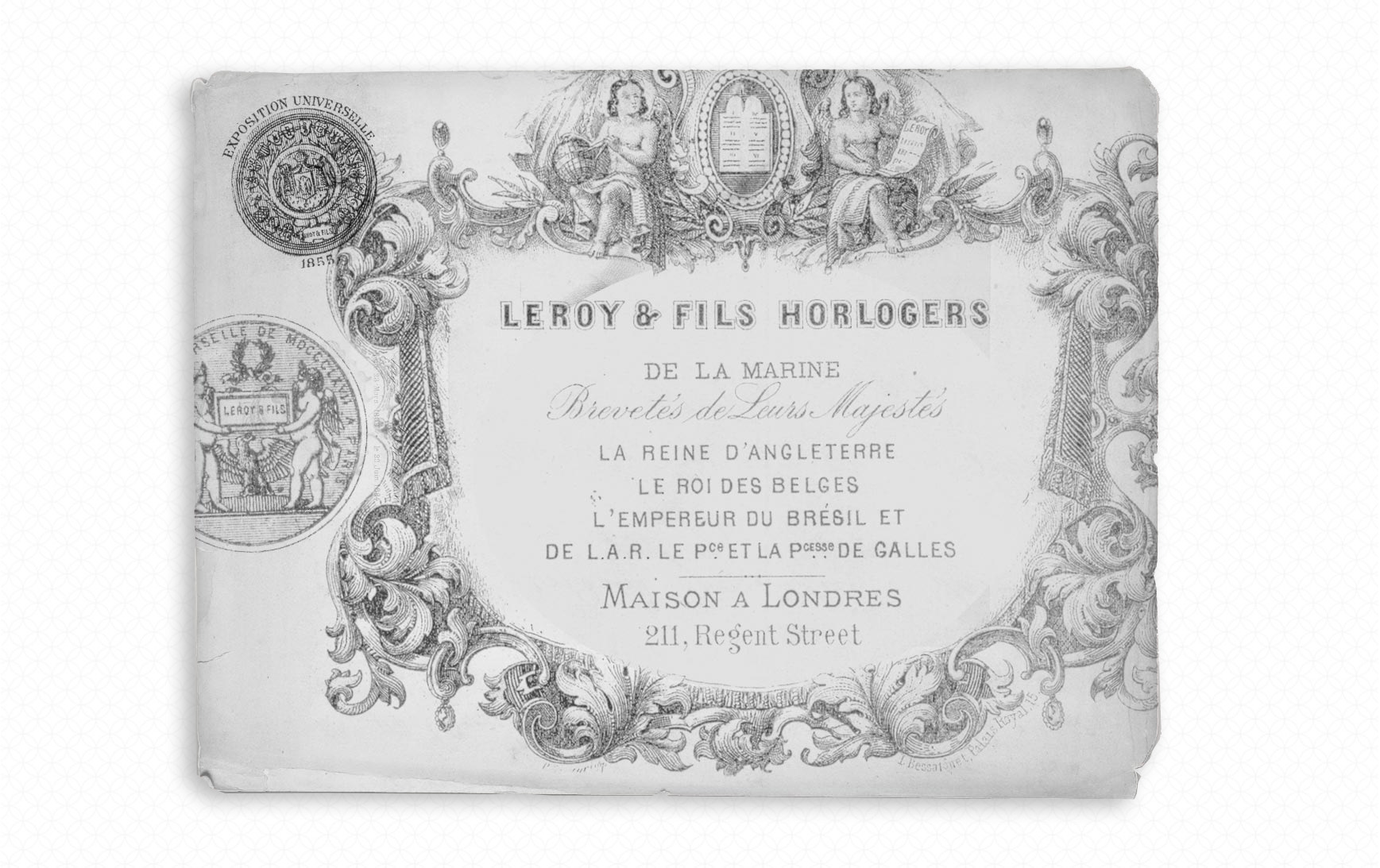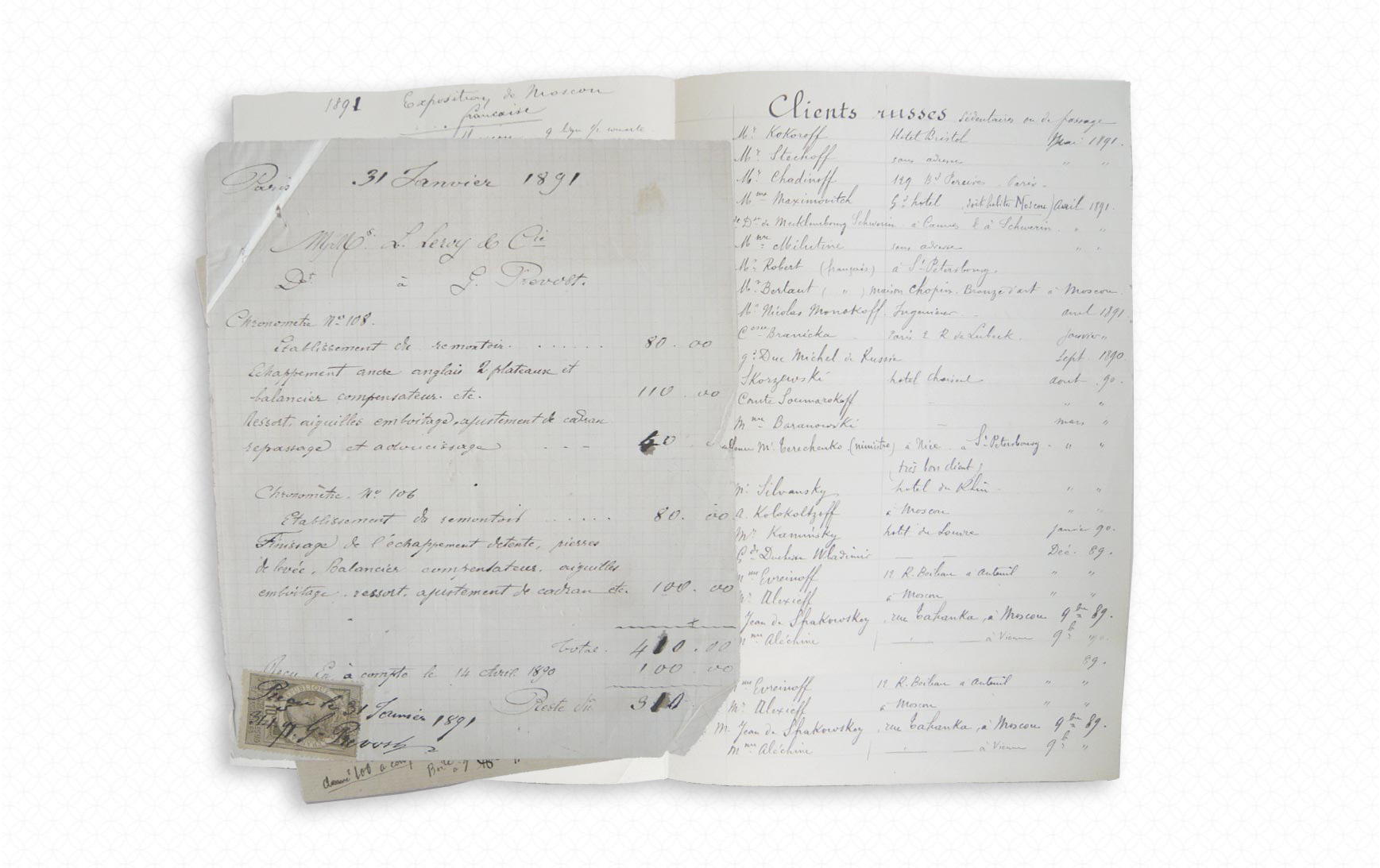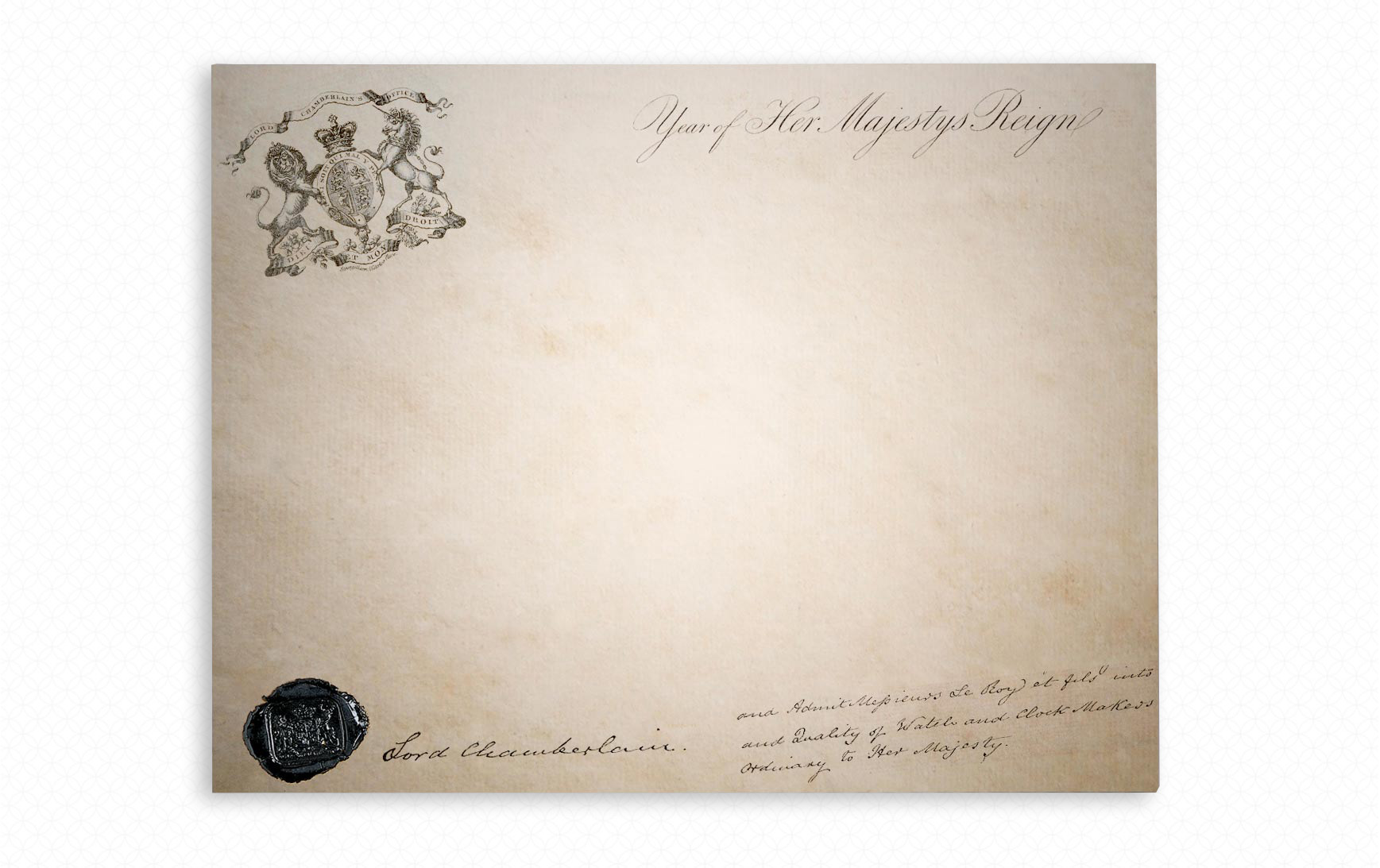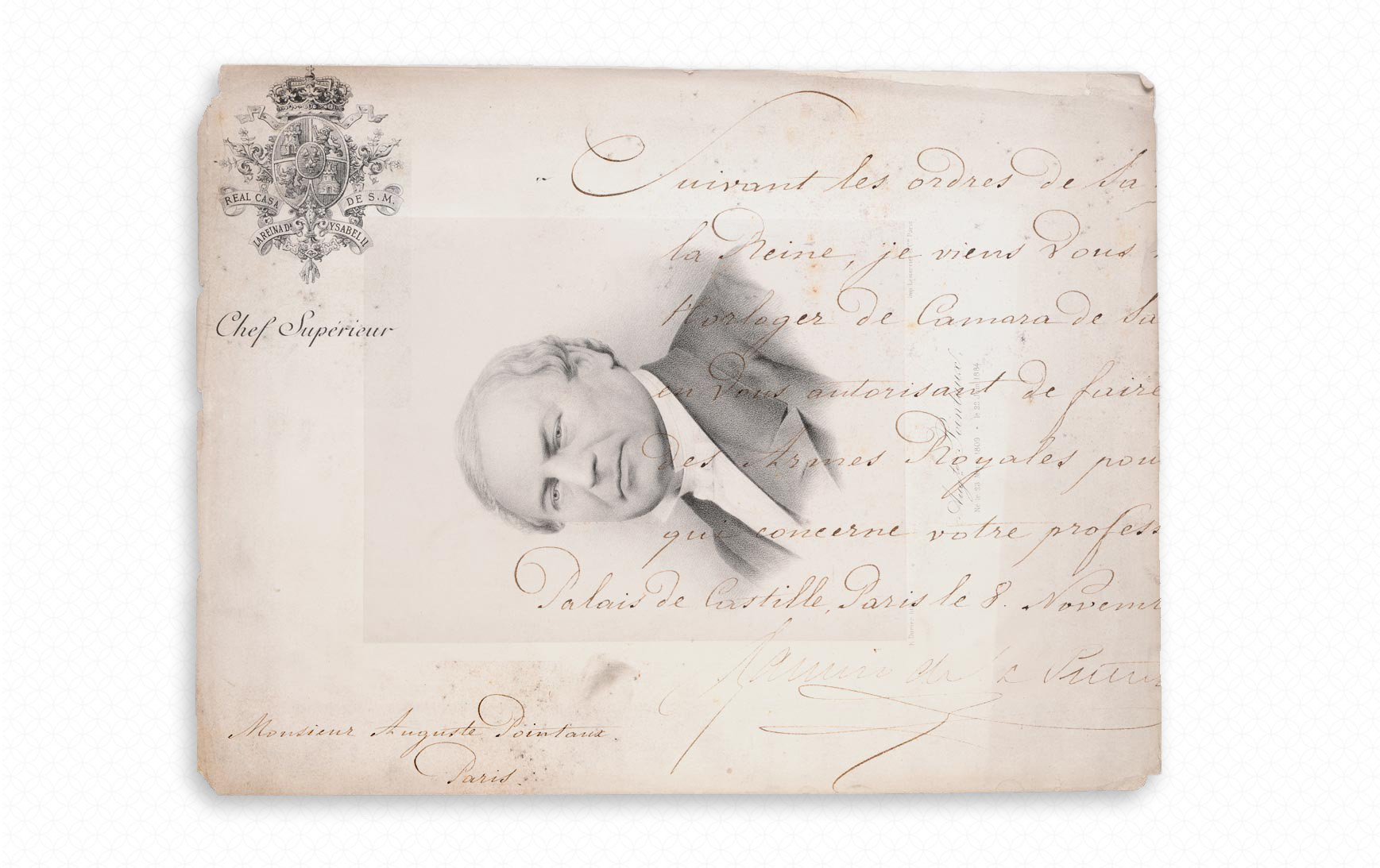The era of the royal watchmakers in the twilight years of the Age of Enlightenment
Basile Le Roy (1731 - † Year XI of the French Republican Calendar),
the origins of the first dynasty
The Age of Enlightenment was a time of incredibly rich discoveries.
Scholars, philosophers and artists shared and compared their ideas
and worldviews. Theirs was a new "enlightened" perspective
and they brought about great changes in the cultural and scientific understanding of the peoples and
Royal Courts of Europe. France and England played leading roles
in this profound social transformation and relied on the
greatest minds in every field to increase their influence and supremacy.
Deeply immersed in this profusion
of innovative ideas, Basile Le Roy, a very young man aged just 16 at the
time, arrived at the workshops of Joseph Quétin, Master Watchmaker
in the Paris Corporation, in the spring of 1747. With the prestigious intellectual backing of
Pierre Le Roy, he signed an apprenticeship contract for a period of
eight years. Little did he know that he would be caught up in one of the most
glorious adventures in watchmaking history.
Large snuffbox-shaped travel "chiming alarm clock"
in gilded brass with engraved silver ring.
Inscribed with the signature “(Basile)-Charles Le Roy, Watchmaker to the King in Paris”,
hallmarked 1788. The piece very probably
belonged to Count Hans Axel de Fersen,
Marshall of the Kingdom of Sweden and a close friend of
Marie-Antoinette, Queen of France.
Leroy Museum Collection
The era of the royal watchmakers in the twilight years of the Age of Enlightenment
The founders of the legendary company, Julien and Pierre Le Roy,
are veritable stars in the firmament of French watchmaking
Basile, an orphan whose father was a woodcutter, bore a surname already etched at the very top of the list of watchmakers of genius by Julien
(1686-1759) and Pierre Le Roy (1717-1785), both Watchmakers to the King.
Julien was renowned for having developed, amongst other things, the first
watch able to mark seconds, but more generally he is
credited with synthesising the best of two rival watchmaking cultures:
French and British. For his part, his son Pierre is seen as
one of the fathers of modern chronometry. His work
would play a crucial role in the race
being run by Europe's various monarchies towards mastery of time at sea,
enabling the precise and fail-safe determination of longitude.
President of the Parisian Corporation, Pierre enjoyed
great renown, despite his very reserved character. In 1776 he was offered a pension and comfortable lodgings by the King, in recompense for
his efforts in the field of research and for the two decades he had spent
developing his famous marine chronometers.
Large "Empire" pocket watch in gold,
two-gong quarter repeater
(by means of pressure on the pendant).
Inscribed with the signature "Le Roy – At the Palais-Royal 13 & 14, No. 4915",
between 1795 and 1800.
Leroy Museum collection
(the former Léon Leroy collection)
The era of the royal watchmakers in the twilight years of the Age of Enlightenment
To give a better idea of the stature of the man and the importance of the
name Le Roy in the microcosm of recognised watchmakers at that time, here is a short extract from the glowing homage belatedly paid to Pierre Le Roy by Ferdinand Berthoud in 1802:
"... he was the most illustrious of the watchmakers to have
honoured or enriched France..."
The annals of French watchmaking history include an impressive
number of watchmakers bearing the names "Le Roy" or
"Leroy": several dozen between the 17th and 19th centuries.
The House we represent claims no direct family link
to some of these illustrious Le Roy forebears (Julien and Pierre for example). However, the technical heritage and the handing down of
expertise are often thought to be beyond doubt, so close was the
collaboration between members of the corporation. The signature of Pierre
Le Roy at the bottom of Basile's apprenticeship contract (carefully
preserved in our archives), is proof of this. The footnotes of history record
that Pierre died heirless in 1785, the year in which
(Basile)-Charles, the son of Basile, founded the company under the
arcades of the Galerie de Pierre in the Palais-Royal.
Large "Empire" pocket watch in silver,
self-winding movement,
perpetual display of seconds, date and
power reserve.
Inscribed with the signature "Le Roy – Paris", no. 2216, between 1795 and 1800.
Leroy Museum Collection
The era of the royal watchmakers in the twilight years of the Age of Enlightenment
(Basile)-Charles Le Roy,
son of Basile, founder of the company in 1785
(Basile)-Charles Le Roy was the watchmaker behind today's company.
Accredited as a Master Watchmaker while still a young 20 year-old, he
was thus entitled to open a shop and an "official" workshop, which he did with his father's help, in the Palais-Royal, recently opened to traders.
Towards 1790, in a France rocked by revolutionary tumult,
his name with its regal overtones and his commercial links to the
monarchy obliged him to use the anagram "Elyor" on some of his pieces.
During the period known as the Terror, around 1793, he went as far as to fictitiously sell his company to an employee of his named Cachard,
repurchasing it after Thermidor (the 11th month in the Republican calendar). By 1794, the political tension was
beginning to subside. The quality of the timepieces produced
in the workshops of the Palais-Royal was quickly recognised by the new leaders in the capital. The House's reputation for excellence
was forever sealed during the last five years of the century
and pieces by Le Roy (very clearly inspired by those of Breguet)
were presented at the Parisian Exhibition in the year VI (1798).
An exceptional and rare "tact" medallion watch,
in gold, guilloché and enamelled, set with 17 carats of diamonds.
Inscribed with the signature "Le Roy – Watchmaker to HM the King and R. Madame, Paris",
no. 3191, circa 1810.
Patek Philippe Museum Collection,
© Patek Philippe Museum, Geneva.
The Age of Splendour
The fame of Le Roy, watchmaker to the imperial family, grew internationally
Frequently considered (in something of an oversimplification) as the purveyors of watches to the
crowned heads of the 18th century, the House saw its fame literally
explode during the following century, both in France and throughout the world. Official purveyor to the imperial family as early as 1805, (Basile)-Charles
Le Roy produced extremely high-quality "tact" or chiming watches,
both traditional and decimal.
Around 1810, primarily due to strong demand from the army,
the production of so-called "officer" clocks temporarily outstripped
that of pocket watches. This new clientele led
the company to engage in its first collaborations with suppliers established in the French-Swiss Jura, in order to respond to ever-growing demand.
The national trade fairs at the beginning of the century (1819, 1823, 1827) confirmed the aura of the prestigious Parisian company, established for 45 years under the arcades of the Palais-Royal and now with Charles-Louis Le Roy (son of Basile Charles) at the helm.
Miniature officer's clock in gilded brass with alarm clock and quarter repeater
using twin hammers on a single gong.
Dial inscribed with the signature Le Roy – Watchmaker to HM the King of Westphalia,
Paris. "Movement inscribed with the signature "Le Roy, Watchmaker to Madame",
No.132 – 378. Circa 1810.
Leroy Museum Collection
The Age of Splendour
Le Roy & Sons, from the Palais-Royal to Regent Street
In 1828, Charles-Louis joined his father in the flourishing concern,
henceforth known as "Le Roy & Fils", watchmakers to the Dukes
of Chartres and Bourbon and then Watchmaker to the King and the Duke of Orléans.
Appointed Watchmaker to the Naval Ministry from 1835, the company was expanding on
all fronts. In the 1850s, the company was brilliantly managed
and numbered no fewer than 50 employees, among the best in the
capital. This growing success was confirmed with the opening, in 1854,
of the first Le Roy boutique in London under the name "Le Roy & Sons" at 296 Regent Street. Under the guidance of the manager, it became
the place-to-be for all aficionados of luxury French watchmaking until 1952.
Large table or mantelpiece chiming clock,
patented lever escapement and perpetual date,
complete with moon phase, barometer and double thermometer
(Celsius and Fahrenheit).
Dial inscribed with the signature "Le Roy & Fils, Palais-Royal, Galerie Montpensier 13
& 15, Paris - 296 Regent Street, London". Movement inscribed with
the signature "Le Roy & Fils, Paris". No. 6666. Circa 1860.
Leroy Museum Collection
The Age of Splendour
Officially appointed Watchmakers to Queen Victoria
The success of the first "Le Roy & Sons" boutique in London
was followed by the opening of a second outlet at 57 New Bond Street.
Bespoke productions and those "By appointment to the Queen" continued to leave the workshops
and led to the unprecedented appointment of the company
as official "Watchmakers to Queen Victoria" in 1863, a title bestowed
in person by Her Majesty. A few years later, the Emperor of
Brazil and Her Majesty Queen Isabelle II of Spain would confer
the same honour on the company. A constant presence at all the
national and European trade fairs, from Madrid to Vienna and
from London to Paris, Le Roy & Fils continued to reap rewards and won
an impressive number of medals for progress, gold medals and other honours.
Small pocket watch in gold, enamelled and gem-set, adapted
to be mounted on a bracelet, commissioned by royal interest
in 1874. Dome inscribed with the signature "Le Roy & Fils, 'To The Queen',
57 New Bond Street, London – Paris."
Made in France and engraved with the royal crown. Circa 1875.
Leroy Museum Collection
The Age of Splendour
Louis Leroy, the emergence of a watchmaker of genius
and master of all disciplines
Born in 1859, eldest son of a family of 14 children, he became familiar at a very early age with the art of measuring time. His father, Théodore-Marie Leroy,
was an illustrious manufacturer of chronometers, Watchmaker to the Navy
and decorated with the Légion d’Honneur. Aged barely 16, he submitted a
much-discussed piece to the competition held by the Parisian
Watchmakers Society. In 1879, he completed a year-long apprenticeship
at a manufacturer’s in Clerkenwell in London and earned a reputation for
eagerness, talent, curiosity and ambition.
At the age of 20, he entered the House of Le Roy in London
before joining the Parisian workshops. His relationship with the managers rapidly took a special and indeed highly personal turn. He became an associate in the business
in 1888 and finally took it over completely in 1889,
changing the company name in the process to
"Leroy & Co, formerly The House of Le Roy & Sons".
Small pocket watch in gold, enamelled and gem-set, adapted
to be mounted on a bracelet, commissioned by royal interest
in 1874. Dome inscribed with the signature "Le Roy & Fils, 'To The Queen',
57 New Bond Street, London – Paris".
Made in France and engraved with the royal crown. Circa 1875.
Leroy Museum Collection
The Age of Excellence
From the Champ de Mars to Square St. Amour
The Universal Exhibition to mark the centenary of the French Revolution
was in full swing. Visitors from the length and breadth of Europe were astonished
to discover a city at the height of its powers, totally transformed by
Baron Haussmann, that was becoming the world centre of fashion and luxury.
The technical and artistic supremacy of France was manifest in
impressive and extraordinary creations such as the Eiffel Tower. This was
1889, the year in which Louis Leroy became the young owner of a century-old House
famed throughout Europe for the quality and
good taste of its creations. A well-travelled man, he was aware that timepieces were being produced in Switzerland,
which were a match for and indeed often outshone
the chronometric quality of products made elsewhere in the world.
An exceptional single push-piece chronograph in gold, perpetual date with moon phase, minute repeater, chronometer-certified, first-class award from the Observatoire de Besançon.Dome inscribed with the signature "Leroy & Co, Watchmakers to the Navy, boulevard de la Madeleine – Paris". No.18486 Commissioned from the workshops in October 1927 and delivered in March 1929 to the Comte de Pierredon.
Leroy Museum Collection
The Age of Excellence
He therefore decided to approach the Jura Arc, the cradle of
Swiss production, and brought about some solid collaborations between the Vallée
de Joux and Le Locle. Top-quality movement blanks and escapements
were purchased from the best workshops there, to be subsequently decorated,
assembled, set and finally encased in Paris.
But distances between Paris and the Jura were great, particularly
during the very long winter period in the Swiss
mountains. It quickly became essential to set up a workshop nearer to
Switzerland and Louis' choice naturally fell on Besançon, "the heart and soul"
of French industrial watchmaking production.
In 1892, the Leroy Workshops were opened on Square St. Amour, in this city
which had recently acquired a powerful new authority:
the "Observatoire National" and its chronometric certification department.
On-board chronometer, detent escapement, balance-staff and escape-wheel arbors jewelled with diamonds, fusee-chain.
Inscribed with the signature "Leroy & Co No.1252".
Produced for the Italian Navy in 1916.
Leroy Museum Collection
The Age of Excellence
From the Palais-Royal to the great Haussmann boulevards
Léon Leroy, Louis' younger brother, joined the company as an associate
in 1895. His arrival enabled Louis to completely overhaul his workforce and absorb, in 1899, the production workshops of his recently deceased father. With the solid foundation of
excellent research and production
skills, Louis engaged in far-ranging collaborations with
some of the greatest talents of Swiss watchmaking. These included in particular
Louis-Benjamin Audemars and Charles Piguet, with whom the House developed
some of the greatest complications of the early
20th century. The House now lacked only a Parisian showcase on a par with
its new ambitions. Following in the wake of the affluent and cosmopolitan clientele
which henceforth frequented only the grand boulevards of the
capital, in 1899 Leroy & Co set up its workshops and shop at
7, Boulevard de la Madeleine, leaving the Palais-Royal after
over a hundred years spent under its arcades.
Special series of 7 automatic watches
Watch No. 2 of the series produced in 1925
Self-winding movement
Case in gold without winding crown
Full date in aperture
Leroy Museum Collection
The Age of Excellence
A prestigious clientele of enthusiastic connoisseurs
A loyal, demanding and often prestigious clientele supported the incredible growth of the society throughout the first half of the 20th
century, thus forever establishing the reputation for excellence of Leroy & Co.
An examination of the order and delivery books, which faithfully record the pieces delivered and the names of the purchasers,
is quite simply a dizzying experience.
Like the European crowned heads, leaders and grand families
of the 19th century, the greatest artists, industrialists, politicians,
philosophers and adventurers of the 20th century were clients and sometimes even friends of the
Leroys. It would be utterly impossible to list this famous clientele exhaustively
but here, in no particular chronological order, are
some of our greatest customers...
Franklin D. Roosevelt, Alfred Nobel, Antoine de St. Exupéry, Jules Védrines, Charles Lindbergh and Alberto Santos-Dumont, Louis Renault,
Émile Delahaye and Ettore Bugatti, Frédéric Chopin, Richard Strauss and Richard Wagner, Gabriel Faure and Debussy, Georges Sand and Alfred de Musset, Marcel Proust, Henry Matisse and many more.
The Leroy 01
For over a century,
the world's most complicated watch
This extraordinary timepiece, a genuine global icon, winner of the Grand Prix Spécial du Jury at the Paris Universal Exhibition in 1900, remained the absolute standard-setter in terms of "ultra-complicated" watchmaking until 1989. For over a century, this watch symbolised the watchmaking expertise of the House of Leroy but also, and more broadly, the wealth of craftsmanship skills available in the Besançon area and in the Swiss Jura Arc in the early 20th century.
General information about the piece
The start of the project: 1st November 1897; piece completed on 15 November 1904.
Movement composed of 975 pieces assembled on 4 mechanical levels.
27 precise and functional indications including 17 relating directly to the
measurement of time, housed in a gold case measuring just 71 mm in diameter
and weighing no more than 228 grams.
Collection of the Museum of Time, City of Besançon
The Leroy 01
Its movement, comprising over 975 pieces on 4 mechanical levels,
was developed and perfected with the expertise of the famous
Swiss watchmaker Charles Piguet in Le Brassus who produced the movement blank or ébauche.
The watch was then assembled, completed and encased in the
Leroy Workshops in Besançon. From order to delivery, it took seven years
of work to complete this masterpiece and, as a mark of respect for all
the protagonists in this incredible and noble adventure, it is our custom to describe this piece as
being born of a "French father" and a "Swiss mother".
General information about the piece
The start of the project: 1st November 1897; piece completed on 15 November 1904.
Movement composed of 975 pieces assembled on 4 mechanical levels.
27 precise and functional indications including 17 relating directly to the
measurement of time, housed in a gold case measuring just 71 mm in diameter
and weighing no more than 228 grams.
Collection of the Museum of Time, City of Besançon
The Leroy 01
The history of the famous Leroy 01 began in 1867, during an
exhibition in which the House presented a piece equipped with nine complications,
an extraordinary feat at the time. This unique watch impressed international collectors' circles,
and Count Nicholas Nostitz
of Moscow went on to order an even more amazing piece
comprising eleven complications. The company rose admirably to the challenge…
It was presented at the Universal Exhibition in 1878 before being
dispatched to Russia.
Hours, minutes, day and date calendars, perpetual month calendar, leap-year indicator, the year for 100 years, moon phase, season indicator, solstices and equinoxes, equation of time, chronograph to 1/5th of a second,, minute and hour counter with reset to zero, power reserve, large and small striking mechanisms, optional hour, quarter and minute repeater (carillon), state of the sky in the northern and southern hemispheres, the time in 125 cities, sunrise and sunset times for Lisbon, thermometer, hygrometer, barometer, altimeter, index-assembly system enabling the watch to be set without being opened, compass, signs of the zodiac
The Leroy 01
In 1896, on the death of its first owner, a famous Portuguese
collector, Doctor Antonio Augusto de Carvalho Monteiro, acquired
Count Nostitz' watch. A demanding customer, he thought it might be possible to include
even more functions and made a request to this effect to Louis
Leroy. He laid out a veritable list of specifications which he summarised in these terms:
produce a watch that will encompass all that contemporary science and technology
can offer – in portable form. After over seven years of
intense work, Louis Leroy handed this latest piece in person to the
King of Portugal, a loyal client of the House, during the monarch’s visit to Paris.
Summoned a few days later to the Palace in Lisbon, Doctor
Carvalho de Monteiro received this extraordinary piece from the hands of the monarch,
to his great satisfaction.
Hours, minutes, day and date calendars, perpetual month calendar, leap-year indicator, the year for 100 years, moon phase, season indicator, solstices and equinoxes, equation of time, chronograph to 1/5th of a second,, minute and hour counter with reset to zero, power reserve, large and small striking mechanisms, optional hour, quarter and minute repeater (carillon), state of the sky in the northern and southern hemispheres, the time in 125 cities, sunrise and sunset times for Lisbon, thermometer, hygrometer, barometer, altimeter, index-assembly system enabling the watch to be set without being opened, compass, signs of the zodiac





